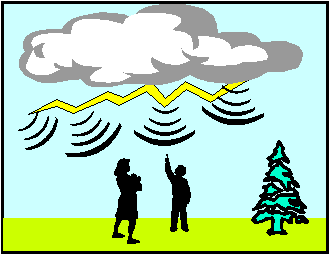 |
 |
| Home | Welcome | What's New | Site Map | Glossary | Weather Doctor Amazon Store | Book Store | Accolades | Email Us |
 | |||||||||||
Watching ThunderWhile the professional scientist may utilize sophisticated audio equipment to study lightning through the properties of its thunder signature, the amateur observer can make many interesting observations with no more equipment than a good watch capable of measuring seconds and a critical ear. The easiest observation is to estimate the distance the lightning stroke is from the observer. The distance between the lightning and the observer can be calculated by counting the number of seconds between the flash and the thunder and dividing by three (3) for distances in kilometers or by five (5) for distances in miles.
With careful listening to thunder, the shape, length and path of a lightning bolt can often be estimated. Arthur A. Few ( in an article entitled "Thunder" published in Scientific American in 1975), has produced some typical sound signatures for several common lightning patterns. By measuring "the delay between the flash and the first thunder heard, the loudest clap and the final rumble...you can estimate the distance to the [lightning] branch nearest you, the main channel and the farthest branch. Also note the total duration of the thunder in order to calculate the minimum length of the channel." [Use the same method of calculation given above to convert the time interval in seconds to distance in kilometres or miles.] Lightning striking the ground nearby gives a loud crack, at times preceded by a short rumble or a ripping noise that likely originates from a small branch of the main lightning channel. A flash made up of several different strokes may generate thunder such that each pulse is heard separately, sounding similar to a short burst of machine-gun fire. Thunder heard as a loud boom rather than a clap is usually generated by a high energy flash some distance from the observer. A crackling thunder racing from one side of the observer to the other results from an over-head, in-cloud lightning flash beginning on one side of the observer and ending on the other.  Safety First!If you are planning a session of observing lightning and thunder, please take proper safety precautions. More people are killed each year by lightning in North America than tornadoes and hurricanes combined. Lightning takes nearly 100 lives and injures over 500 yearly in the United States alone. (Between 1966 and 1995, tornadoes claimed an average of 73 lives a year.) Open structures are not considered safe. An enclosed building is the safest place to be when lightning strikes. If you can't be in a building, an enclosed vehicle with a hard top and the windows rolled up is an option. But remember, it's the metal casing around you that protects you, not the rubber tires. Don't touch the sides of the car. However thunder is heard, it has the potential to arouse the deepest feelings. The sudden clap, particularly when unexpected, can scare even the calmest person or awaken one from deep sleep. A distant rumbling may bring a sigh of relief from farmers needing rain for their crops or a curse from the lips of golfers or picnickers, whose recreation will soon be ended. Learn More From These Relevant Books
|
|||||||||||
 |
To Purchase Notecard, |
Now Available! Order Today! | |
 |
 |
NEW! Now Available in the US! |
The BC Weather Book: |


